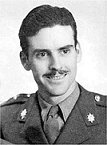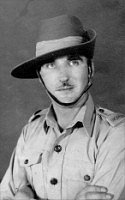Both the 2nd and 7th Battalions of the Worcestershire Regiment saw service in Burma. The 7th Battalion were the first to see action arriving in April 1944 in the Assam region.
Following the fall of Singapore in February 1942, the 2nd Battalion, who were in India, were moved to Madras as there was the belief at the time that the Japanese would invade India across the Bay of Bengal. It was not until November 1944 that the 2nd Battalion finally advanced in to Burma.
Early in 1944 the situation in Burma was critical. The Japanese intention was nothing less than a full-scale invasion of India with a subsidiary objective to gain possession of the all-weather Manipur road and threaten the British air bases in the Brahmaputra valley, upon the continued existence of which the British air supply to China over “the hump” depended.
In the first week of April 1944 troops of the Japanese 31st Division had cut the Manipur road between Kohima and Dimapur, while farther south they were again across the road a few miles north of Imphal. As a result of the enemy’s astonishing advance the 4th Corps were therefore completely isolated in Imphal, and it was to move to their assistance and open the Manipur road that the 33rd Corps under General Stopford was hurried into Assam. Speed was essential and 2nd Division were rushed up by rail, road, and air. Inevitably there was a certain amount of administrative confusion with brigades and units arriving the other end spasmodically, and a lot of improvisation and guess work enforced on harassed Unit Commanders and their staffs.
On 1st April 1944 the 7th Battalion Worcestershire Regiment crossed the Brahmaputra river at Gauhati and entered the operational area of Assam, being the first troops of the Division on this occasion to taste the conditions of the Burma war.
They then moved on to railhead at Dimapur and on 2nd April a perimeter was formed to cover the approaches to Dimapur from the north. From 5th April onwards the Battalion was busy patrolling the Kohima road, working in with the armoured cars. The village of Zubza was reached by “D” Company in Motor Transport. Progress was on foot, the immediate objective being a blown bridge. In the darkness they failed to make their objective by dawn and were caught in an ambush, whereupon they concentrated at Zubza and were joined by the rest of the Battalion.
Awarded for service in the Burma Campaign between 11th December 1941 & 2nd September 1945 (inclusive).
Service in the provinces of Bengal and Assam in the period 1st May 1942 to 2nd September 1945 also qualified. Service in China and Malaya between 16th February 1942 & 2nd September 1945 was also counted.

C.S.M. Bert Chapman
Killed in action at
Dawete.
CLICK ON PHOTO ABOVE FOR DETAILS

7th Battalion - Sergents Mess at Secunderabad (1945)
(click on the image for larger photos with names)
CONFLICT AT KOHIMA (1944)
7th BATTALION PERSONNEL
at B.O.Rs. Kalyan, India,
1945
CLICK HERE for a full list of 7th Battalion personnel. Giving date they initially embarked from the UK, company and rank as at 1945.
2nd Battalion Worcestershire Regiment in Burma 1944-45
Chapter 1 - Introduction
Chapter 2 - The March From The Chindwin To The Irrawaddy
Chapter 3 - The Fighting In The Irrawaddy Bridgehead
Chapter 4 - The Breakout From The Bridgehead
Chapter 5 - The Road To Mandalay
Chapter 6 - The Battle For Mandalay
Chapter 7 - The Operations On The Shan States Road

Read Fred's own story of his experience in Burma and the actions the 7th Battalion Worcestershire Regiment at Kohima.
Click on Fred's photo to access his full story.
Frederick Weedman was called up for National Service at Dudley on 15th July 1939. He joined the 1st Militia Worcestershire Regiment at Norton Barracks, Worcester. In October 1939, only one month after war broke out, he was one of 120 men who were drafted to make the numbers up of a Territorial Army unit, the 7th Battalion, Worcestershire Regiment, who were stationed at Marlborough. Frederick Weedman was now promoted to the rank of Corporal in 'C' Company. The 7th Battalion were being equipped to be sent to France to join the British Expeditionary Force (B.E.F.)
On the 15th January 1940, Frederick Weedman with the rest of the 7th Battalion, embarked on the MV Amsterdam at Southampton and sailed for Le Havre, France. When the B.E.F. were evacuated from Dunkirk he had been separated from the 7th Battalion. Frederick eventually made contact with the French Resistance who arranged for passage on a French Destroyer heading to Weymouth.
The next 2 years were taken up by defense work in the U.K. In April 1942, the 7th Battalion embarked from Liverpool for Bombay, India. Finally in March 1944 the 7th Battalion moved to Assam and then into Burma.
CQMS FRED WEEDMAN PHOTO ALBUMS (7th Battalion)

Worcestershire Regt Kohima Veterans
with captured Japanese Gun (click on photo for larger image)
at their annual reunion in Kidderminster
(Chairman CQMS Fred Weedman - 3rd on the right)

Passing a supply dump near Kohima
As a Corporal with the 7th Battalion, in June 1944 he war awarded the Military Medal. He was then promoted to Sergeant. In December 1944 he was granted a commission to 2nd/Lieutenant. He was awarded the Military Cross in January 1946.

This Memorial was unveiled by Field Marshal Sir William Slim, who was at the time commanding 14th Army in Burma.
It is made from once piece of solid stone which formed part of a Naga formation of stones similar, but smaller, than Stonehenge. These stones were situated on a Spur near the village of Maram, south of Kohima.
The 7th Battalion Worcestershire Regiment supported by Tanks, M.M.G.'s and Artillery, captured the village and the spur after a battle lasting one day.
It was subsequently discovered from captured documents that the Japanese had been ordered to hold this position for ten days. The 75 m.m. gun which is now held by the Worcestershire Regimental Museum was captured during the action, the Japanese gunner being bayoneted by a member of the 7th Battalion.
The stone was with great difficulty, and with the assistance of the Naga Hillsmen, moved to its present site, at one end of the 2nd Division's War Cemetery. The Cemetery is situated on a commanding piece of ground at Kohima on the site, which was originally the District Commissioner's Bungalow.
CLICK HERE FOR LIST OF 7th BATTALION MEN REMEMBERED ON THIS MEMORIAL STONE


